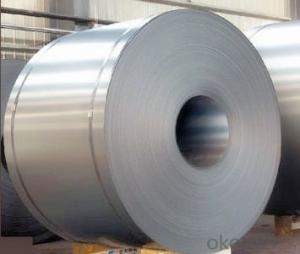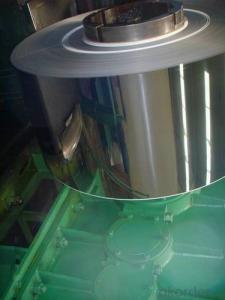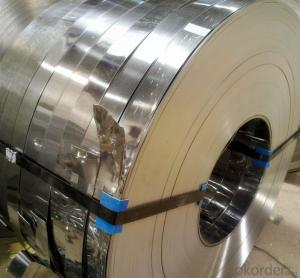201 SERIOUS COLD ROLLED STAINLESS STEEL COILS/SHEETS
- Loading Port:
- Guangzhou
- Payment Terms:
- TT OR LC
- Min Order Qty:
- 100 m.t.
- Supply Capability:
- 20000 m.t./month
OKorder Service Pledge
OKorder Financial Service
You Might Also Like
Quick Details
| Grade: | 2B | Standard: | JIS,AISI,GB | Length: | as customers' requested |
| Thickness: | 2.5mm;3.0mm;4.0mm or as required | Width: | 485mm,510mm,600mm or as required | Place of Origin: | Shanxi China (Mainland) |
| Brand Name: | CMAX | Model Number: | 201 | Type: | Coil |
| Application: | Decoration,Boiler Plate,Chemical Industry,Container plate,ship | Certification: | SGS,ISO | Color: | natural color |
| Available Finish: | 2B/BA/8K/No.4/SB/HL | Edge: | slit edge and mill edge | Features: | accurate dimensions |
| Manufacture technology: | cold drawn,pickling, hot rolled and cold rolled | DDQ: | slivery bright surface | Quality: | high quality Hot rolled stainless steel coil 201 |
| Stock: | Always in stock | Item: | Hot rolled stainless steel coil 201 |
Packaging & Delivery
| Packaging Detail: | Standard export packing or as customer's requirement Hot rolled stainless steel coil 201 |
| Delivery Detail: | In 15 days |
Specifications
Hot rolled stainless steel coil 201
Width:485mm,510mm,600mm or as required
Thickness: 2.5mm;3.0mm;4.0mm or as required
Product Description
Stainless steel coil; stainless steel cold rolled coil;201 stainless steel coil; stainless steel coil
A. stainless steel coil
B. with competitive prices and fast delivery
C. High quality
Tisco 201 stainless steel coil
Thickness: 2.5mm;3.0mm;4.0mm or as required
Width: 485mm,510mm,600mm or as required
Length: As required
Material:201
201 stainless steel coil chemical composition
201 stainless steel coil | ||||||||
Grade | Chemical composition | |||||||
C | Si | Mn | P | S | Ni | N | Cr | |
% | % | % | % | % | % | % | % | |
201 | ≤0.15 | ≤0.75 | 5.5~7.50 | ≤0.060 | ≤0.030 | 3.50~5.50 | ≤0.25 | 16.00-18.00 |
201 stainless steel coil physical property
Physical Property | ||||
density | Strength of extension | yield strength | elongation | modulus of elasticity |
g/cm³ | psi | psi | % | psi |
7.93 | 100000-180000 | 50000-15000 | 55-60 | 29000000 |
Item | 201 stainless steel coil |
Technical | Hot rolled and cold rolled |
Standard | ASTM A240,GB/T3280-2007,JIS4304-2005,ASTM A167,EN10088-2-2005,GB/T3280-2007,EN10095-99,JIS4312,etc |
Material | 201,202,304,304L,309S,310S,316,316L,316Ti,430 |
Surface | NO.1,2b,4K,8k,HL,mirror finish |
Thickness | 0.3-100mm |
Width | 500-2000mm |
Price term | FOB,CFR,CIF |
Application | Stainless steel coil applies to construction field, ships building industry, petroleum, chemical industries, war and electricity industries, food processing and medical industry, boiler heat exchanger, machinery and hardware fields. Stainless steel coil can be made according to the customer’s requirements. |
Contact | If you have any question, please feel free to contact me. |
- Q:How can stainless steel strips be welded together?
- Stainless steel strips can be welded together using various welding techniques such as TIG (Tungsten Inert Gas) welding, MIG (Metal Inert Gas) welding, or even spot welding. Each of these methods has its own advantages and considerations. TIG welding is commonly used for stainless steel due to its ability to produce high-quality and precise welds. It involves using a non-consumable tungsten electrode to create an electric arc between the electrode and the base metal. A filler metal is then fed into the weld puddle to join the stainless steel strips together. TIG welding offers excellent control over the heat input and provides a clean and aesthetically pleasing weld. MIG welding, on the other hand, is a more common method for joining stainless steel strips in industrial applications. It involves using a consumable electrode wire that is continuously fed through a welding gun. The wire serves as both the filler material and the electrode. MIG welding is relatively faster than TIG welding and is suitable for thicker stainless steel strips. However, it may produce a less visually appealing weld compared to TIG welding. Spot welding is another option for joining stainless steel strips, especially if they are thin. This method involves applying an electric current to create resistance heat between the two strips at specific spots. The heat generated melts the metal, and pressure is applied to fuse the strips together. Spot welding is a quick and efficient process, commonly used in mass production settings. Before welding stainless steel strips, it is essential to clean the surfaces to remove any contaminants and oxide layers that can affect the quality of the weld. Additionally, proper shielding gases, such as argon or helium, should be used to protect the weld from oxidation and ensure the weld's integrity. It is crucial to select the appropriate welding technique based on the thickness, desired weld quality, and specific requirements of the stainless steel strips. Consulting with a professional welder or referring to welding guidelines provided by the manufacturer is recommended to ensure a successful welding process.
- Q:Can stainless steel strips be machined?
- Stainless steel strips are indeed capable of being machined. Machining stainless steel strips encompasses a range of procedures, including cutting, drilling, milling, and turning. Nevertheless, it is crucial to acknowledge that stainless steel poses a challenge due to its hardness, necessitating the utilization of suitable tools and techniques for machining. Furthermore, the ease and efficacy of the machining process are contingent upon the particular kind of stainless steel and its inherent properties.
- Q:Are stainless steel strips resistant to humidity?
- Stainless steel strips demonstrate resistance to humidity. This is due to the exceptional corrosion resistance of stainless steel, which encompasses its ability to withstand humidity and moisture. The inclusion of chromium in stainless steel generates a protective layer on the surface, preventing oxidation and corrosion. As a result, stainless steel strips exhibit high resistance against the impacts of humidity, rendering them a suitable option for a range of applications in humid settings, including kitchen appliances, outdoor structures, and industrial equipment. However, it should be noted that extended exposure to exceedingly high humidity or corrosive environments may still lead to some degree of corrosion, although it would be significantly less when compared to other materials.
- Q:What are the factors affecting the electrical conductivity of 111 stainless steel strips?
- The electrical conductivity of 111 stainless steel strips can be influenced by various factors. Firstly, the alloy composition of the stainless steel plays a significant role. The type and amount of elements present in the alloy can greatly affect conductivity. For example, the inclusion of elements like chromium, nickel, and manganese can enhance conductivity, while elements like carbon can decrease it. Additionally, the heat treatment process used during manufacturing can also impact conductivity. By altering the microstructure of the material, heat treatment can affect the movement of electrons within the strips. The grain size and orientation of the strips are important considerations as well. Smaller grain sizes and a more uniform grain orientation generally result in higher conductivity as they allow for better electron flow. Furthermore, the surface condition of the strips can affect conductivity. Factors such as roughness, contamination, or oxidation can impede the flow of electrons, leading to decreased conductivity. Temperature is another crucial factor. As temperature increases, the thermal vibrations of atoms intensify, hindering the movement of electrons and decreasing conductivity. Impurities and defects within the strips can also impact conductivity. Impurities introduce additional scattering centers for electrons, while defects like dislocations hinder electron flow, resulting in reduced conductivity. Lastly, mechanical deformation, such as rolling or stretching, can modify the crystal structure of the strips and introduce dislocations, thereby influencing the movement of electrons and impacting conductivity. It is important to note that the specific combination and interaction of these factors will ultimately determine the electrical conductivity of 111 stainless steel strips.
- Q:What are the recommended storage conditions for 111 stainless steel strips?
- The recommended storage conditions for 111 stainless steel strips are in a dry and clean environment, away from moisture, humidity, and any corrosive substances. It is advisable to store them indoors, preferably in a temperature-controlled area, with adequate ventilation to prevent the formation of condensation. Additionally, it is important to ensure the strips are properly stacked or stored in a way that avoids any distortion, bending, or damage.
- Q:How do stainless steel strips perform in extreme cold temperatures?
- Stainless steel strips are renowned for their exceptional ability to withstand extreme temperatures, including frigid environments. Their resistance to cold is due to their low thermal conductivity, enabling them to retain their strength and structural integrity even in freezing conditions. This unique characteristic makes them highly suitable for a wide range of applications in extremely cold settings. The high nickel content in stainless steel provides it with outstanding toughness and ductility, allowing it to withstand extreme cold temperatures without becoming brittle or losing its mechanical properties. This makes stainless steel strips perfect for use in environments where temperature fluctuations are common, such as refrigeration units, cryogenic storage tanks, and cold storage facilities. In addition, stainless steel strips demonstrate excellent resistance to corrosion and oxidation in extreme cold temperatures. The chromium in stainless steel forms a protective oxide layer on the surface, acting as a barrier and preventing the metal from reacting with the surrounding environment. This ensures that the stainless steel strips maintain their durability and aesthetic appeal, even in harsh cold conditions. Moreover, stainless steel strips have a low coefficient of thermal expansion, meaning they expand and contract less than other metals when exposed to temperature changes. This property makes stainless steel strips less susceptible to warping or distortion, ensuring their dimensional stability in extreme cold temperatures. All in all, stainless steel strips excel in extreme cold temperatures due to their low thermal conductivity, high toughness, resistance to corrosion, and dimensional stability. These qualities make them a reliable and versatile choice for various applications in cold environments.
- Q:How do stainless steel strips compare to other metals in terms of cost?
- Compared to other metals, stainless steel strips tend to be more expensive due to their unique properties and superior resistance to corrosion. Despite their higher initial cost, stainless steel strips prove to be cost-effective in the long run as they require minimal maintenance and exhibit excellent durability. In contrast, alternative metals like carbon steel or aluminum may have lower upfront expenses, but they are more susceptible to corrosion and wear, resulting in additional costs for repairs or replacements. Furthermore, stainless steel strips have a high scrap value, making them a more economically sound choice for recycling and sustainability purposes. In conclusion, although stainless steel strips may have a higher initial price, their long-term benefits and advantages make them a worthy investment.
- Q:Can stainless steel strips be welded?
- Yes, stainless steel strips can be welded.
- Q:How do stainless steel strips perform in the presence of chlorine?
- Stainless steel strips generally perform well in the presence of chlorine. Stainless steel is known for its corrosion resistance properties, and it forms a passive chromium oxide layer on its surface that provides protection against oxidation and corrosion. This oxide layer acts as a barrier, preventing chlorine from reaching the underlying steel and causing corrosion. However, in certain conditions, stainless steel can still be susceptible to localized corrosion, such as pitting and crevice corrosion, in the presence of high concentrations of chlorine or in the presence of other corrosive agents. It is important to consider the specific grade of stainless steel being used, as some grades may have better resistance to chlorine than others. Additionally, proper maintenance and cleaning procedures should be followed to ensure the longevity and performance of stainless steel strips in chlorine-rich environments.
- Q:Can stainless steel strips be used for architectural balustrades?
- Yes, stainless steel strips can be used for architectural balustrades. Stainless steel is a popular choice for architectural applications due to its durability, strength, and aesthetic appeal. It is resistant to corrosion and can withstand outdoor elements, making it an ideal material for balustrades. Stainless steel strips can be easily shaped into various designs, providing flexibility and creativity in architectural projects.
1. Manufacturer Overview |
|
|---|---|
| Location | |
| Year Established | |
| Annual Output Value | |
| Main Markets | |
| Company Certifications | |
2. Manufacturer Certificates |
|
|---|---|
| a) Certification Name | |
| Range | |
| Reference | |
| Validity Period | |
3. Manufacturer Capability |
|
|---|---|
| a)Trade Capacity | |
| Nearest Port | |
| Export Percentage | |
| No.of Employees in Trade Department | |
| Language Spoken: | |
| b)Factory Information | |
| Factory Size: | |
| No. of Production Lines | |
| Contract Manufacturing | |
| Product Price Range | |
Send your message to us
201 SERIOUS COLD ROLLED STAINLESS STEEL COILS/SHEETS
- Loading Port:
- Guangzhou
- Payment Terms:
- TT OR LC
- Min Order Qty:
- 100 m.t.
- Supply Capability:
- 20000 m.t./month
OKorder Service Pledge
OKorder Financial Service
Similar products
New products
Hot products
Hot Searches
Related keywords






























